
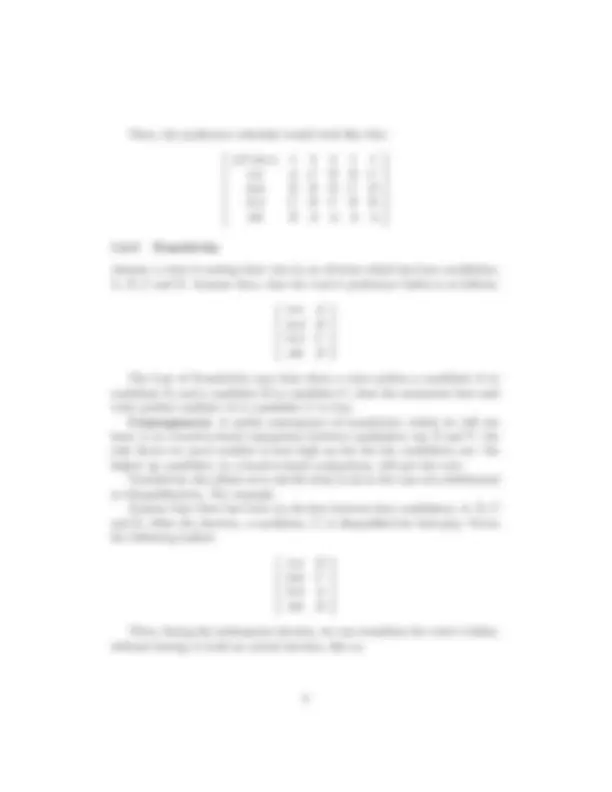
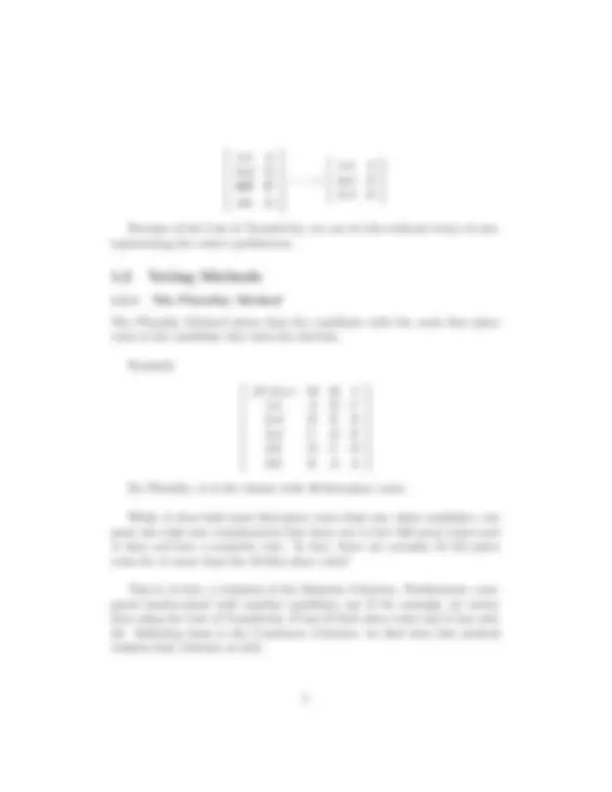
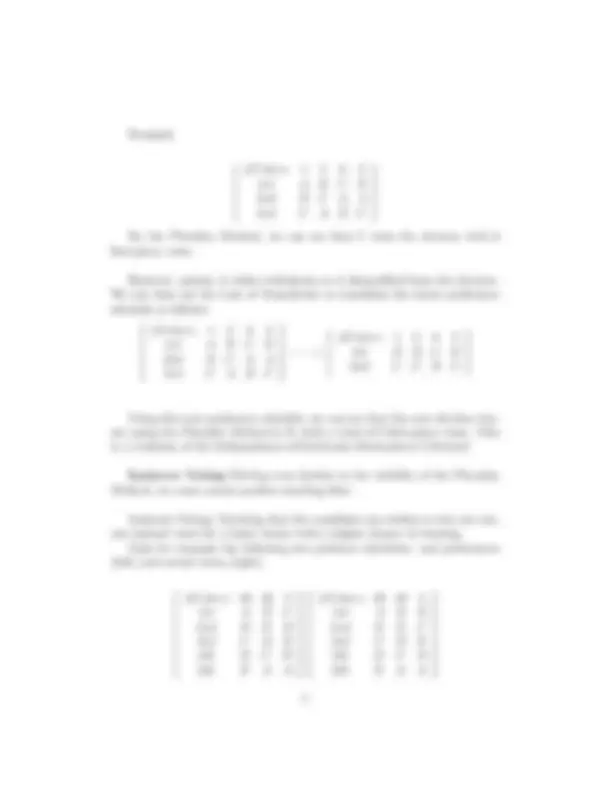
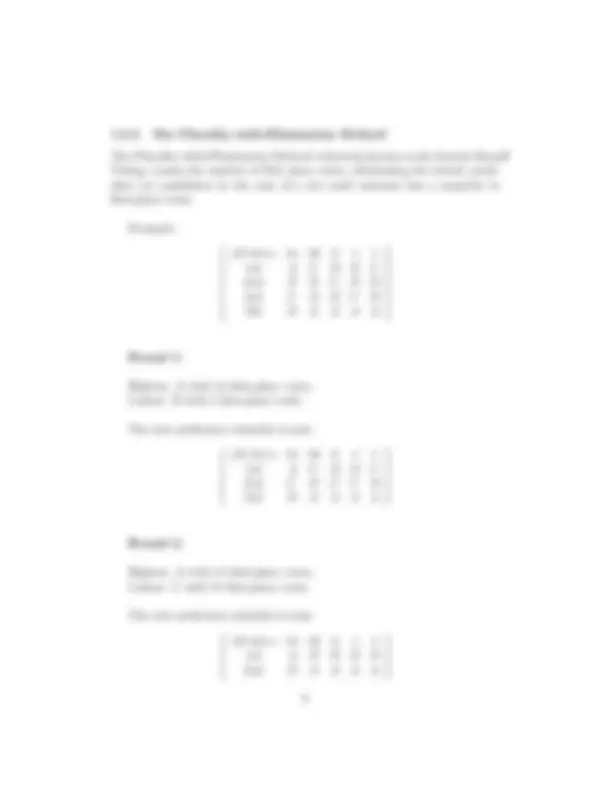

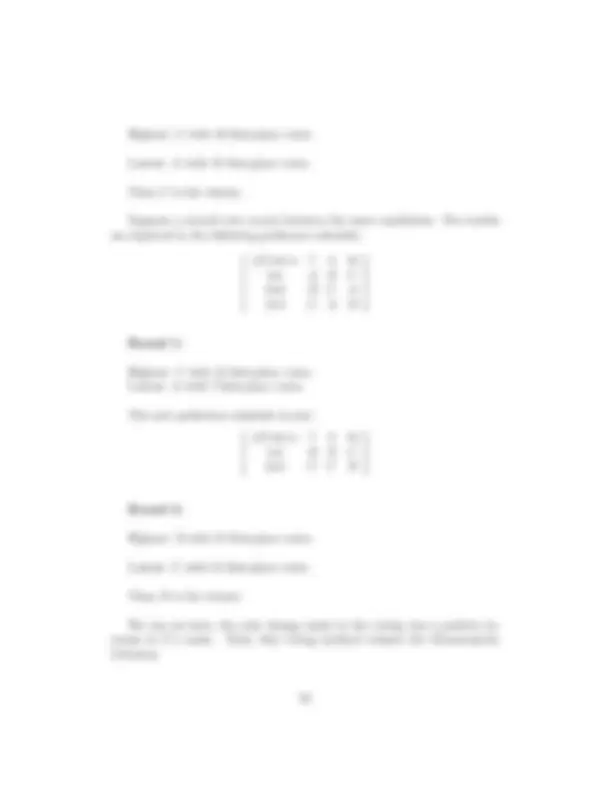
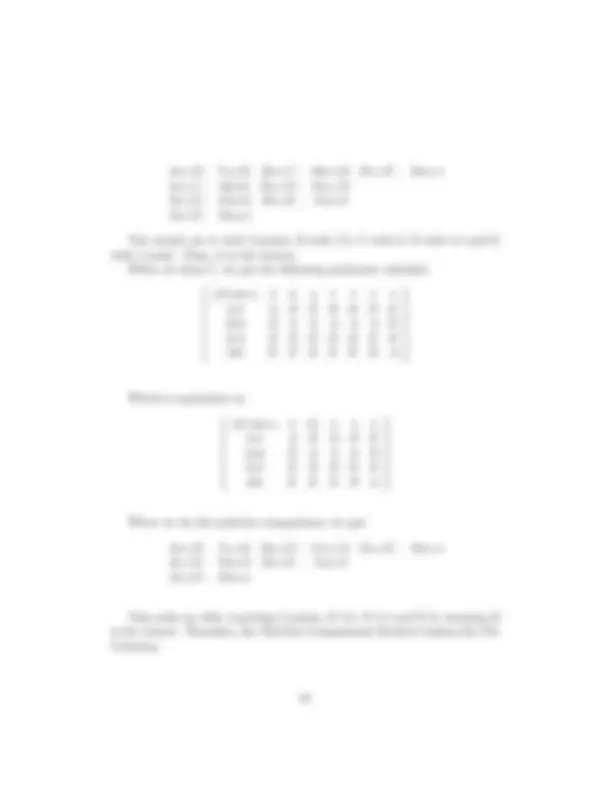
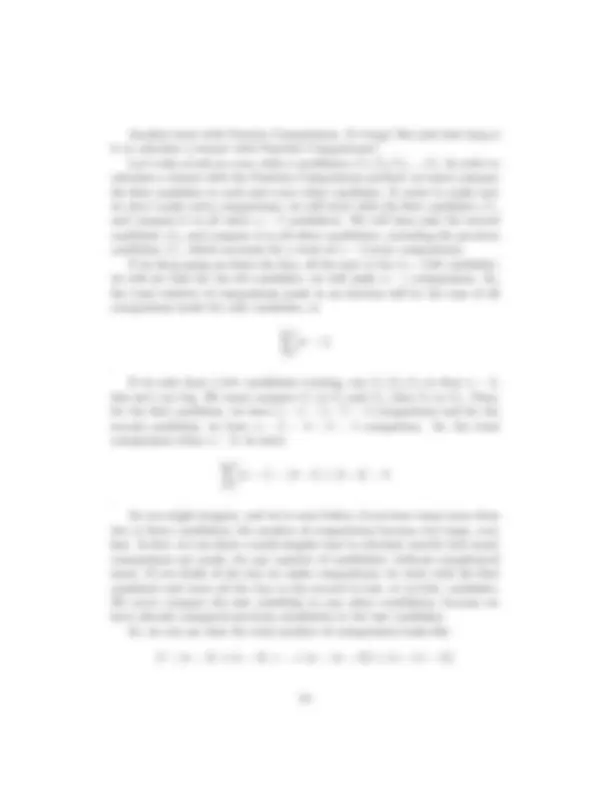
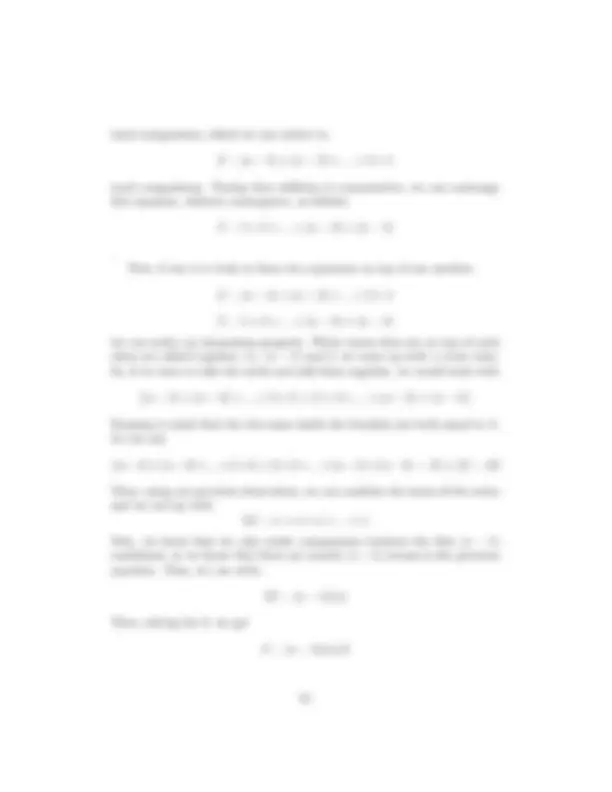
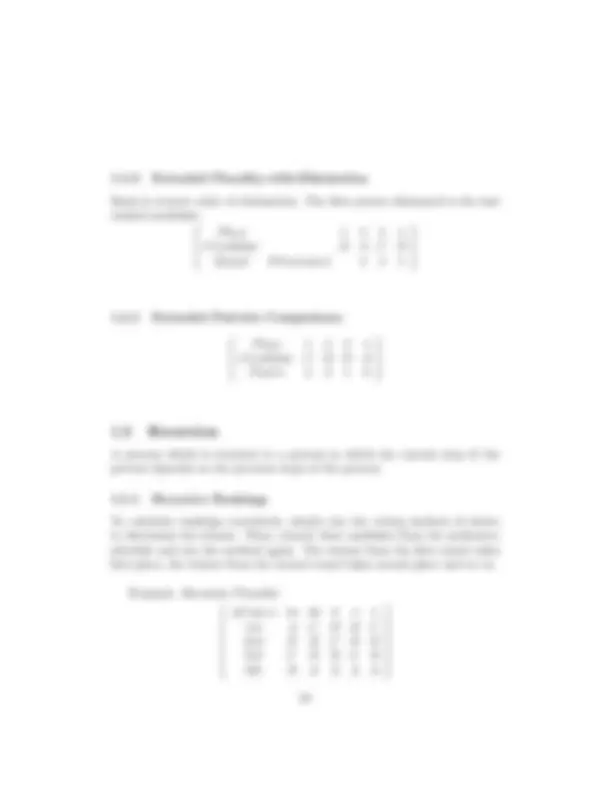
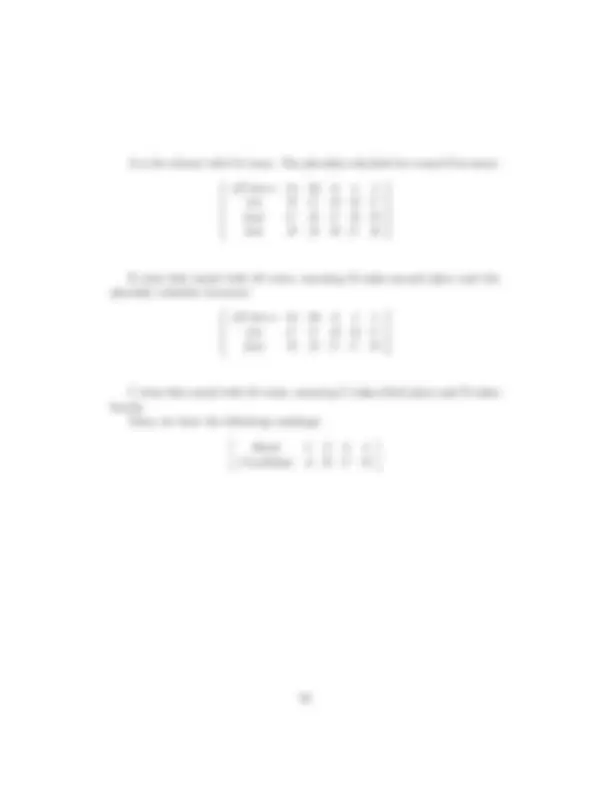


Study with the several resources on Docsity

Earn points by helping other students or get them with a premium plan


Prepare for your exams
Study with the several resources on Docsity

Earn points to download
Earn points by helping other students or get them with a premium plan
Community
Ask the community for help and clear up your study doubts
Discover the best universities in your country according to Docsity users
Free resources
Download our free guides on studying techniques, anxiety management strategies, and thesis advice from Docsity tutors
An in-depth analysis of various voting systems and fairness criteria, focusing on the Plurality, Borda Count, and Plurality-with-Elimination Methods. concepts such as the Majority Criterion, Monotonicity Criterion, Independence-of-Irrelevant-Alternatives (IIA) Criterion, preference schedules, transitivity, and the Law of Transitivity. It also includes examples and comparisons of these methods to help illustrate their concepts.
Typology: Study notes
1 / 19

This page cannot be seen from the preview
Don't miss anything!












1.1.1 The Majority Criterion:
A candidate with the majority of the first-place votes should win the election.
1.1.2 The Condorcet Criterion:
The Condorcet Candidate should always win the election. That is to say, when the candidates are compared two at a time, the candidate who beats each of the other candidates (the Condorcet Candidate) should always win.
1.1.3 The Monotonicity Criterion:
Suppose candidate X wins an election, but there is (for some reason) another [subsequent] election. If the only voting changes are those that positively affect candidate X, then candidate X should win the subsequent election.
1.1.4 The Independence-of-Irrelevant-Alternatives (IIA) Criterion:
Suppose candidate X wins an election, but there is (for some reason) another [subsequent] election. If the only change is another candidate drops out, or is disqualified, then candidate X should still win. The converse, which states the winner should not be penalized by the introduction of a candidate who has no chance of winning, is also true.
1.2.1 The Preference Ballot
A preference ballot is a ballot, by which, the voter casts their vote giving an ordered list of each candidate in the election, in descending order, starting with their favorite candidate.
Example: (^)
1 st A 2 nd B 3 rd C 4 th D
1.2.2 The Preference Schedule
A preference schedule is a condensed representation of all the ballots cast in an election. Example: Suppose there is an election between four candiates, A, B, C and D. The results of this election are shown below:
1 st A 2 nd B 3 rd C 4 th D
1 st C 2 nd B 3 rd D 4 th A
1 st D 2 nd C 3 rd B 4 th A
1 st B 2 nd D 3 rd C 4 th A
1 st C 2 nd D 3 rd B 4 th A
1 st A 2 nd B 3 rd C 4 th D
1 st A 2 nd B 3 rd C 4 th D
1 st A 2 nd B 3 rd C 4 th D
1 st C 2 nd B 3 rd D 4 th A
1 st C 2 nd B 3 rd D 4 th A
1 st B 2 nd D 3 rd C 4 th A
1 st A 2 nd B 3 rd C 4 th D
1 st A 2 nd B 3 ////rd^ C// 4 th D
1 st A 2 nd B 3 rd D
Because of the Law of Transitivity, we can do this without worry of mis- representing the voter’s preferences.
1.3.1 The Plurality Method
The Plurality Method states that the candidate with the most first place votes is the candidate who wins the election.
Example:
#V oters 49 48 3 1 st A B C 2 nd B E B 3 rd C D E 4 th D C D 5 th E A A
By Plurality, A is the winner with 49 first-place votes.
While A does hold more first-place votes than any other candidate, one must also take into consideration that there are in fact 100 total voters and A does not have a majority vote. In fact, there are actually 51 5th place votes for A–more than the 49 first place votes!
This is, in fact, a violation of the Majority Criterion. Furthermore, com- pared head-to-head with another candidate, say B for example, we notice that using the Law of Transitivity, B has 51 first place votes and A has only
Example:
#V oters 4 2 6 3 1 st A B C B 2 nd B C A A 3 rd C A B C
By the Plurality Method, we can see that C wins the election with 6 first-place votes.
However, assume A either withdraws or is disqualified from the election. We can then use the Law of Transitivity to transform the above preference schedule as follows:
#V oters 4 2 6 3 1 st A B C B 2 nd B C A A 3 rd C A B C
− − >
#V oters 4 2 6 3 1 st B B C B 2 nd C C B C
Using this new preference schedule, we can see that the new election win- ner using the Plurality Method is B, with a total of 9 first-place votes. This is a violation of the Independence-of-Irrelevant-Alternatives Criterion!
Insincere Voting Delving even further in the viability of the Plurality Method, we come across another startling flaw:
Insincere Voting: Knowing that the candidate one wishes to win can not, one instead votes for a lesser choice with a higher chance of winning. Take for example the following two prefence schedules: real preferences (left) and actual votes (right).
#V oters 49 48 3 1 st A B C 2 nd B E B 3 rd C D E 4 th D C D 5 th E A A
#V oters 49 48 3 1 st A B B 2 nd B E C 3 rd C D E 4 th D C D 5 th E A A
However, we can see that A has both a majority of the votes (6 first-place votes of 9 total votes) and is also the Condorcet Candidate. However, the winner here is B, not A, with 32 points. This shows that The Borda Count Method violates both the Majority Criterion and the Condorcet Criterion.
Example:
#V oters 4 2 6 3 1 st A B C B 2 nd B C A A 3 rd C A B C
By the Borda Count Method, the winner here is A. Suppose, then, that B is disqualified. The new preference schedule would be as follows:
#V oters 4 2 6 3 1 st A C C A 2 nd C A A C
Now, by the Borda Count Method, C is the winner! This is a violation of the IIA Criterion!
1.3.3 The Plurality-with-Elimination Method
The Plurality-with-Elimination Method–otherwise known as the Instant Runoff Voting–counts the number of first place votes, eliminating the lowest candi- date (or candidates in the case of a tie) until someone has a majority in first-place votes.
Example:
#V oters 14 10 8 4 1 1 st A C D B C 2 nd B B C D D 3 rd C D B C B 4 th D A A A A
Round 1:
Highest: A with 14 first-place votes. Lowest: B with 4 first-place votes.
The new preference schedule is now:
#V oters 14 10 8 4 1 1 st A C D D C 2 nd C D C C D 3 rd D A A A A
Round 2:
Highest: A with 14 first-place votes. Lowest: C with 11 first-place votes.
The new preference schedule is now:
#V oters 14 10 8 4 1 1 st A D D D D 2 nd D A A A A
Highest: C with 18 first-place votes.
Lowest: A with 11 first-place votes.
Thus, C is the winner.
Suppose a second vote occurs between the same candidates. The results are depicted in the following preference schedule:
#V oters 7 8 14 1 st A B C 2 nd B C A 3 rd C A B
Round 1:
Highest: C with 14 first-place votes. Lowest: A with 7 first-place votes.
The new preference schedule is now:
#V oters 7 8 14 1 st B B C 2 nd C C B
Round 2:
Highest: B with 15 first-place votes.
Lowest: C with 14 first-place votes.
Thus, B is the winner.
We can see here, the only change made in the voting was a positive in- crease in C’s count. Thus, this voting method violates the Monotonicity Criterion.
Example:
#V oters 4 2 6 3 1 st A B C B 2 nd B C A A 3 rd C A B C
Using the Plurality-with-Elimination method, we can show that B is the winner with 9 first-place votes.
Round 1:
Highest: C with 6 first-place votes. Lowest: A with 4 first-place votes.
The new preference schedule is now:
#V oters 4 2 6 3 1 st B B C B 2 nd C C B C
Round 2:
Highest: B with 9 first-place votes.
Lowest: C with 6 first-place votes.
Thus, B is the winner.
Now, if we were to remove C from the election, we would find that A would win with 10 first-place votes. This is a violation of the IIA Criterion.
We start with the following preference schedule:
#V oters 4 2 6 3 1 st A B A B 2 nd B A B A
Avs.B : 7 vs. 15 Bvs.C : 10 vs. 12 Dvs.E : 18 vs. 4 Avs.C : 16 vs 6 Bvs.D : 11 vs. 11 Avs.D : 13 vs. 9 Bvs.E : 14 vs. 8 Avs.E : 18 vs. 4
The results are A with 3 points, B with 2.5, C with 2, D with 1.5 and E with 1 point. Thus, A is the winner. When we drop C, we get the following preference schedule:
#V oters 2 6 4 1 1 4 4 1 st A B B B D D E 2 nd D A A A A A D 3 rd B D D D B E B 4 th E E E E E B A
Which is equivalent to:
#V oters 2 11 1 4 4 1 st A B D D E 2 nd D A A A D 3 rd B D B E B 4 th E E E B A
When we do the pairwise comparisons, we get:
Avs.B : 7 vs. 15 Bvs.D : 11 vs. 11 Dvs.E : 18 vs. 4 Avs.D : 13 vs. 9 Bvs.E : 14 vs. 8 Avs.E : 18 vs. 4
This ends up with A getting 2 points, B 2.5, D 1.5 and E 0, meaning B is the winner. Therefore, the Pairwise Comparisons Method violates the IIA Criterion.
Another issue with Parwise Comparisons: It’s long! But just how long is it to calculate a winner with Pairwise Comparisons? Let’s take a look at a race with n candidates, C 1 , C 2 , C 3 , ..., Cn. In order to calculate a winner with the Pairwise Comparisons method, we must compare the first candidate to each and every other candidate. In order to make sure we don’t make extra comparisons, we will start with the first candidate, C 1 , and compare it to all other n − 1 candidates. We will then take the second candidate, C 2 , and compare it to all other candidates, excluding the previous candidate, C 1 , which accounts for a total of n − 2 more comparisons. If we keep going on down the line, all the way to the (n − 1)th candidate, we will see that for the ith candidate, we will make n − i comparisons. So, the total number of comparisons made in an election will be the sum of all comparisons made for each candidate, or
n∑− 1
i=
(n − i)
. If we only have a few candidates running, say C 1 , C 2 , C 3 so that n = 3, this isn’t too big. We must compare C 1 to C 2 and C 3 , then C 2 to C 3. Thus, for the first candidate, we have n − 1 = 3 − 1 = 2 comparisons and for the second candidate, we have n − 2 = 3 − 2 = 1 comparison. So, the total comparisons when n = 3, we have:
n∑− 1
i=
(n − i) = [3 − 1] + [3 − 2] = 3
. As you might imagine, and we’ve seen before, if you have many more than two or three candidates, the number of comparisons become very large, very fast. In fact, we can show a much simpler way to calculate exactly how many comparisons are made, for any number of candidates, without complicated sums. If you think of the way we make comparisons, we start with the first candidate and move all the way to the second to last, or (n-1)th, candidate. We never compare the last candidate to any other candidates, because we have already compared previous candidates to the last candidate. So, we can see that the total number of comparisons looks like
S = (n − 1) + (n − 2) + ... + (n − (n − 2)) + (n − (n − 1))
So, we can safely assume that for any number of candidates, n, using the Pairwise Comparisons method we have the total number of comparisons as
n∑− 1
i=
(n − i) = (n − 1)(n)/ 2 (1)
In fact, we can actually generalize this form to something even more powerful. Noting that
n∑− 1
i=
(n − i) = (n − 1) + (n − 2) + ... + 2 + 1
is the same in both directions, we can go as far as to say
n∑− 1
i=
(n − i) = 1 + 2 + ... + (n − 2) + (n − 1) =
n∑− 1
i=
i
We can then generalize this formula to the following form:
n∑− 1
i=
i = (n − 1)(n)/ 2
Replacing (n − 1) with a sum of a full n terms, we can even go as far as to say that the sum of any n consecutive integers,
∑^ n
i=
i = (n)(n + 1)/ 2 (2)
Now, with this we can really take a good look at just how long the Pairwise Comparisons Method truly is. As we saw before, with three candidates, we have a total of three comparisons. Using our new method for calcuating the total number of comparisons, we can see that when n = 3, the total number of comparisons is, as expected,
(n − 1)(n)/2 = (3 − 1)(3)/2 = (2)(3)/2 = 3
Now, let’s take a look at something a little larger. Suppose there were six candidates–double the number of candidates from the first example. We would then have (n − 1)(n)/2 = (6 − 1)(6)/2 = 15
For twice as many candidates, we already have five times the number of comparisons. You can imagine just how tedius it would be to have to do 15 different head-to-head comparisons.
The idea behind ranking is to come up with a way to not only determine the winner of the election, but to also determine who came in second, third, etc. We’ll use the example from the text to create rankings for each of the methods:
#V oters 14 10 8 4 1 1 st A C D B C 2 nd B B C D D 3 rd C D B C B 4 th D A A A A
1.4.1 Extended Plurality
In order to rank with the Plurality method, you simply arrange the candi- dates by the number of first place votes received. We’ll also use something which looks very much like a preference schedule to depict the rankings.
P lace 1 2 3 4 Candidate A C D B V otes 14 11 8 4
1.4.2 Extended Borda Count
Assume the results of a Borda Count Election are as follows:
A: 79 points B: 106 points C: 104 points D: 81 points
P lace 1 2 3 4 Candidate B C D A BordaP oints 106 104 81 79
A is the winner with 14 votes. The plurality schedule for round 2 becomes:
#V oters 14 10 8 4 1 1 st B C D B C 2 nd C B C D D 3 rd D D B C B
B wins this round with 18 votes, meaning B takes second place and the plurality schedule becomes:
#V oters 14 10 8 4 1 1 st C C D D C 2 nd D D C C D
C wins this round with 25 votes, meaning C takes third place and D takes fourth. Thus, we have the following rankings: [ Rank 1 2 3 4 Candidate A B C D
]